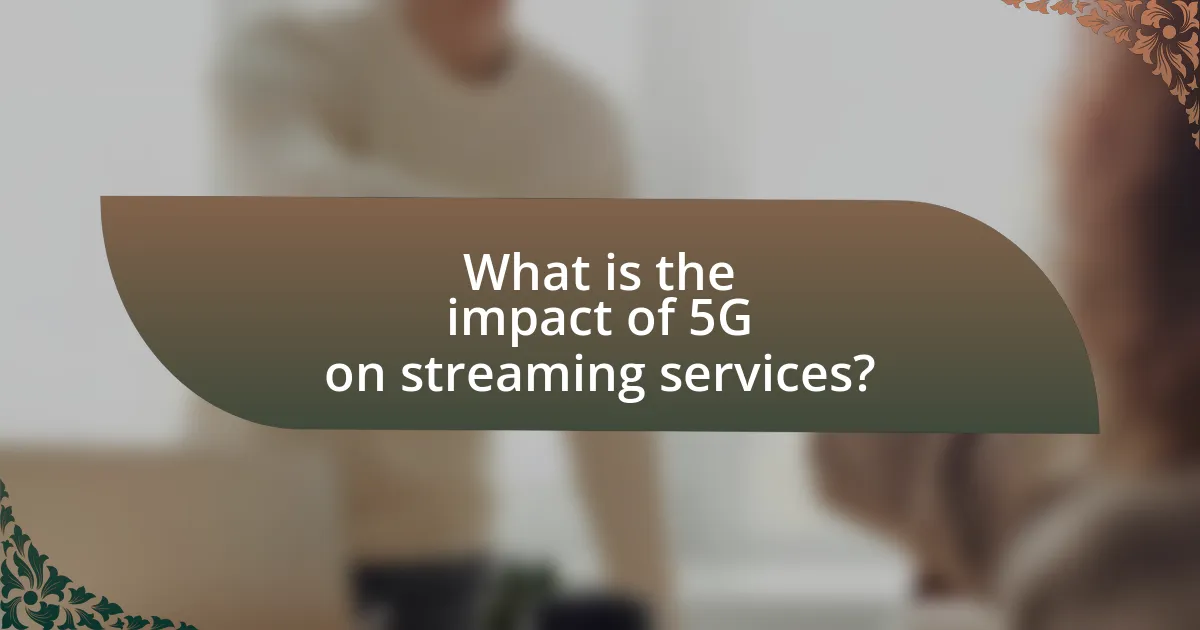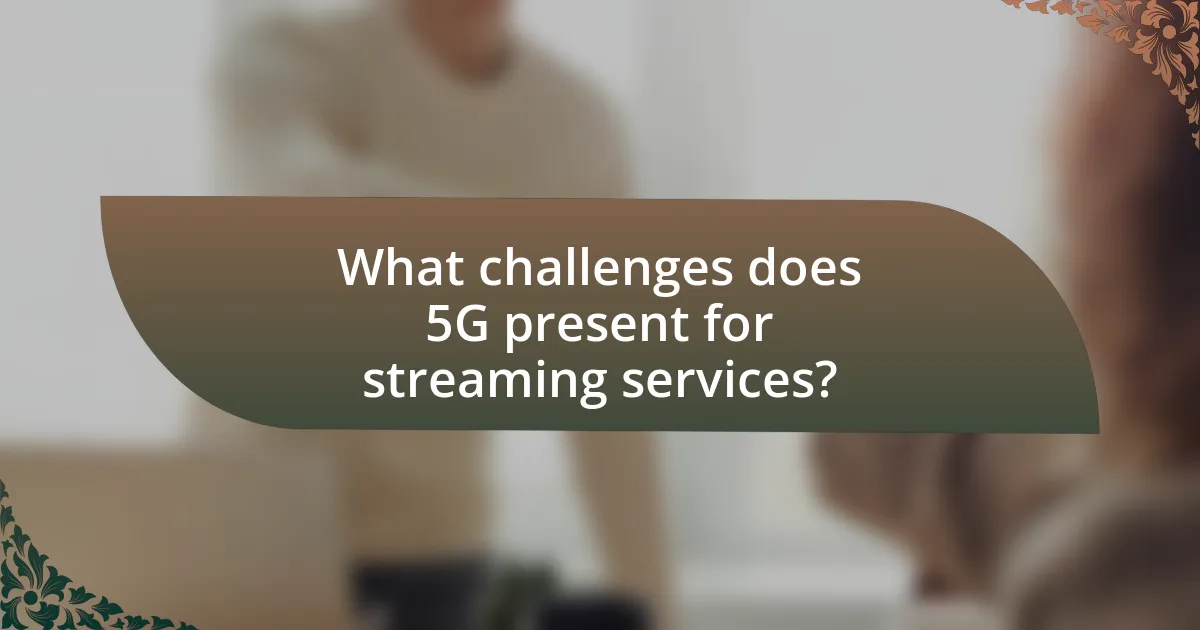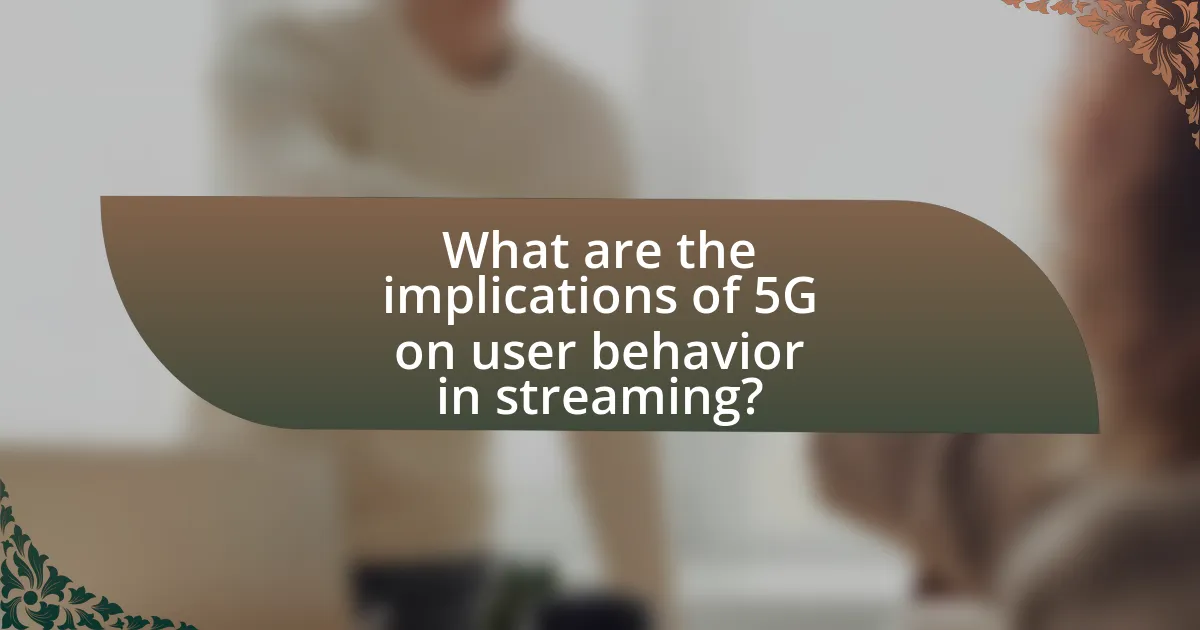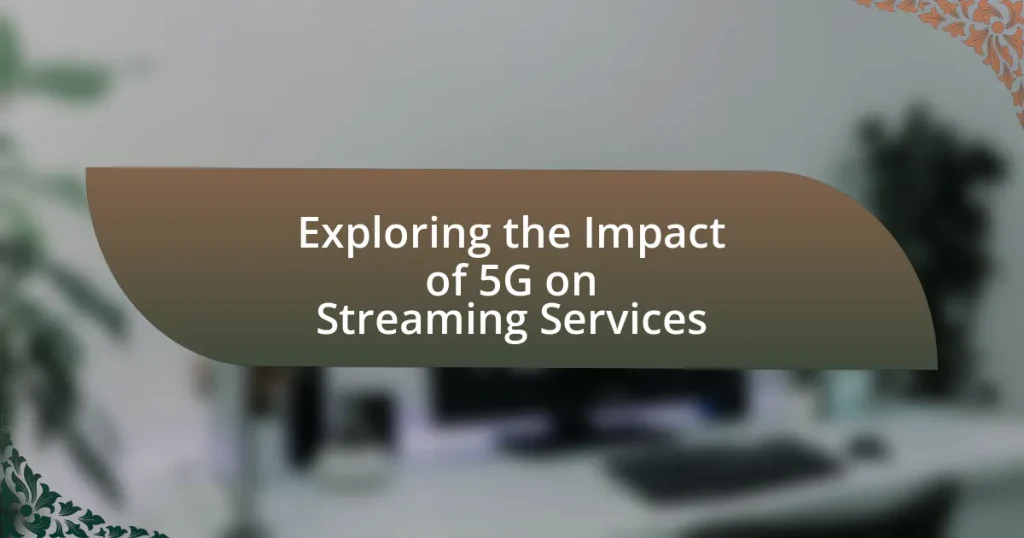The article explores the impact of 5G technology on streaming services, highlighting its ability to provide faster data speeds, lower latency, and increased network capacity. It details how 5G enhances streaming quality by enabling seamless playback of high-definition and 4K content, reducing buffering times, and supporting real-time interactions in live streaming scenarios. Key features of 5G, such as higher bandwidth and improved network capacity, are discussed, along with the potential challenges and infrastructure requirements for streaming providers. Additionally, the article examines how 5G influences user behavior, engagement, and consumption patterns, ultimately transforming the streaming landscape.

What is the impact of 5G on streaming services?
5G significantly enhances streaming services by providing faster data speeds, lower latency, and increased network capacity. This technology allows users to stream high-definition and 4K content seamlessly, reducing buffering times and improving overall viewing experiences. According to a report by the GSMA, 5G networks can deliver speeds up to 100 times faster than 4G, enabling smoother playback and higher-quality video streams. Additionally, the reduced latency of 5G, which can be as low as 1 millisecond compared to 30-50 milliseconds for 4G, facilitates real-time interactions in live streaming scenarios, such as gaming and virtual events. Overall, 5G’s capabilities are poised to transform how consumers access and enjoy streaming content.
How does 5G technology enhance streaming quality?
5G technology enhances streaming quality by providing significantly higher data transfer speeds and lower latency compared to previous generations. This allows for smoother playback of high-definition and 4K content without buffering, as 5G can support download speeds exceeding 1 Gbps. Additionally, the increased bandwidth enables multiple users to stream simultaneously without degradation in quality, making it ideal for crowded environments. According to a report by the GSMA, 5G networks can deliver up to 100 times the capacity of 4G networks, which directly contributes to improved streaming experiences.
What are the key features of 5G that improve streaming?
The key features of 5G that improve streaming include higher bandwidth, lower latency, and enhanced network capacity. Higher bandwidth allows for faster data transfer rates, enabling high-definition and 4K streaming without buffering. Lower latency, which can be as low as 1 millisecond compared to 30-50 milliseconds in 4G, ensures that data is transmitted almost instantaneously, improving the responsiveness of live streaming and interactive content. Enhanced network capacity supports a greater number of devices simultaneously, reducing congestion and maintaining quality even in crowded areas. These features collectively enhance the overall streaming experience by providing smoother, faster, and more reliable access to content.
How does 5G reduce buffering and latency in streaming?
5G reduces buffering and latency in streaming by providing significantly higher data transfer speeds and lower response times compared to previous generations of mobile networks. With peak download speeds reaching up to 10 Gbps and latency as low as 1 millisecond, 5G enables seamless streaming of high-definition content without interruptions. This is achieved through advanced technologies such as millimeter-wave frequencies, which offer greater bandwidth, and network slicing, which allocates dedicated resources for specific applications. As a result, users experience smoother playback and quicker load times, enhancing the overall streaming experience.
What changes can users expect in streaming experiences with 5G?
Users can expect significantly enhanced streaming experiences with 5G due to its higher bandwidth and lower latency. The increased bandwidth allows for faster data transfer rates, enabling users to stream high-definition and even 4K content without buffering. Additionally, the reduced latency, which can be as low as 1 millisecond compared to 30-50 milliseconds with 4G, improves real-time interactions in live streaming scenarios, such as gaming or virtual events. These advancements are supported by the fact that 5G networks can support up to 1 million devices per square kilometer, facilitating seamless connectivity and improved user experiences across multiple devices simultaneously.
How will 5G affect video resolution and quality?
5G will significantly enhance video resolution and quality by providing higher bandwidth and lower latency. This technology enables streaming services to deliver ultra-high-definition (UHD) content, such as 4K and 8K videos, with minimal buffering. For instance, 5G networks can support data rates exceeding 10 Gbps, which is substantially higher than 4G, allowing for richer visual experiences and improved frame rates. Additionally, the reduced latency of 5G, often below 10 milliseconds, ensures smoother playback and real-time interactions, further elevating the overall viewing experience.
What new streaming formats may emerge with 5G?
New streaming formats that may emerge with 5G include ultra-high-definition (UHD) streaming, augmented reality (AR) streaming, and virtual reality (VR) streaming. The increased bandwidth and lower latency of 5G technology enable the transmission of higher quality video content, allowing for seamless UHD experiences that were previously limited by network constraints. Additionally, 5G’s capabilities support interactive AR and immersive VR formats, enhancing user engagement and providing new avenues for content delivery. For instance, a report by the GSMA indicates that 5G networks can support data rates exceeding 10 Gbps, facilitating these advanced streaming formats.
Why is 5G important for the future of streaming services?
5G is important for the future of streaming services because it significantly enhances data transmission speeds and reduces latency. This technology enables seamless streaming of high-definition and 4K content without buffering, which is crucial as consumer demand for high-quality video increases. According to a report by the GSMA, 5G networks can deliver speeds up to 100 times faster than 4G, allowing for instantaneous downloads and improved user experiences. Additionally, the low latency of 5G, often below 10 milliseconds, supports real-time interactions, making it ideal for live streaming events and interactive content.
How does 5G support the growth of live streaming events?
5G supports the growth of live streaming events by providing significantly higher data transfer speeds, lower latency, and increased network capacity. These enhancements enable seamless streaming of high-definition and 4K content, allowing viewers to enjoy a more immersive experience without buffering or interruptions. For instance, 5G networks can achieve speeds up to 10 Gbps, which is up to 100 times faster than 4G, facilitating the transmission of large video files in real-time. Additionally, the reduced latency of around 1 millisecond compared to 30-50 milliseconds in 4G networks ensures that live interactions, such as viewer comments and reactions, occur almost instantaneously, enhancing audience engagement during events. This combination of speed and responsiveness is crucial for the success of live streaming platforms, driving their adoption and growth in various sectors, including entertainment, sports, and education.
What role does 5G play in the expansion of virtual and augmented reality streaming?
5G significantly enhances the expansion of virtual and augmented reality streaming by providing higher data transfer speeds, lower latency, and increased network capacity. These improvements enable seamless streaming of high-resolution VR and AR content, which requires substantial bandwidth and minimal delay for an immersive experience. For instance, 5G networks can achieve speeds up to 10 Gbps, compared to 4G’s maximum of around 1 Gbps, allowing for real-time interactions and high-quality visuals essential for VR and AR applications. Additionally, the reduced latency of 5G, often below 10 milliseconds, ensures that user actions are reflected instantly in the virtual environment, which is critical for maintaining immersion and user engagement.

What challenges does 5G present for streaming services?
5G presents several challenges for streaming services, primarily related to network infrastructure and content delivery. The increased speed and capacity of 5G networks can lead to higher expectations for video quality and lower latency, which may strain existing streaming service architectures that are not optimized for such demands. Additionally, the rollout of 5G is uneven, with many areas still relying on 4G or lower technologies, creating disparities in user experience. According to a report by the International Telecommunication Union, while 5G can support up to 1 million devices per square kilometer, the actual deployment and coverage can be inconsistent, affecting streaming reliability. Furthermore, the transition to 5G requires significant investment in new technology and infrastructure by streaming providers, which can be a barrier to entry for smaller companies.
What are the potential drawbacks of 5G for streaming providers?
The potential drawbacks of 5G for streaming providers include increased costs, network congestion, and limited coverage in rural areas. Streaming providers may face higher infrastructure and operational expenses due to the need for advanced technology and equipment to support 5G networks. Additionally, while 5G offers faster speeds, the initial rollout can lead to congestion as more users connect, potentially affecting streaming quality. Furthermore, 5G coverage is not uniformly available, particularly in rural regions, which can limit access for users and reduce the potential audience for streaming services.
How might increased data usage impact streaming costs?
Increased data usage can lead to higher streaming costs due to the need for more bandwidth and infrastructure investment. As streaming services deliver higher quality content, such as 4K and HDR, the amount of data consumed per user rises significantly. For instance, streaming 4K video can use up to 7 GB per hour, compared to 1 GB per hour for standard HD. This increased demand necessitates service providers to invest in more robust servers and network capabilities to handle the traffic, which can result in higher operational costs. Consequently, these costs may be passed on to consumers through increased subscription fees or data charges.
What infrastructure challenges do streaming services face with 5G?
Streaming services face several infrastructure challenges with 5G, primarily related to network capacity, latency, and content delivery. The increased demand for high-definition and 4K streaming requires robust network infrastructure to handle the higher data rates that 5G offers. Additionally, while 5G promises lower latency, the actual implementation can vary significantly based on geographic coverage and the existing infrastructure of telecom providers. For instance, a report by the International Telecommunication Union indicates that achieving widespread 5G coverage necessitates significant investment in new cell towers and fiber-optic networks, which can be a barrier for streaming services relying on consistent performance. Furthermore, the transition from 4G to 5G may lead to temporary disruptions in service quality, impacting user experience during the rollout phase.
How can streaming services adapt to the 5G landscape?
Streaming services can adapt to the 5G landscape by enhancing their content delivery and user experience through improved streaming quality and reduced latency. With 5G’s capability to provide download speeds up to 10 Gbps and latency as low as 1 millisecond, streaming platforms can offer higher resolution content, such as 4K and 8K video, without buffering. This technological advancement allows for seamless live streaming and interactive features, such as augmented reality and virtual reality experiences. Additionally, streaming services can leverage edge computing to process data closer to users, further optimizing performance and reducing load times. The integration of these technologies will not only improve user satisfaction but also attract a broader audience, as evidenced by the increasing demand for high-quality streaming content in markets where 5G is being deployed.
What strategies can streaming platforms implement to leverage 5G?
Streaming platforms can implement strategies such as enhancing video quality, optimizing content delivery, and expanding interactive features to leverage 5G technology. By utilizing 5G’s high bandwidth and low latency, platforms can offer ultra-high-definition (UHD) streaming, which requires significantly more data than standard definitions. For instance, 5G can support 4K and even 8K streaming, allowing platforms to attract users seeking superior viewing experiences.
Additionally, streaming services can optimize content delivery networks (CDNs) to reduce buffering and improve load times, capitalizing on 5G’s faster data transfer rates. This can lead to a more seamless user experience, which is crucial for retaining subscribers. Furthermore, platforms can introduce interactive features such as augmented reality (AR) and virtual reality (VR) content, which are more feasible with the increased data capacity and speed of 5G networks.
These strategies not only enhance user engagement but also differentiate streaming services in a competitive market, as evidenced by the growing demand for high-quality content and immersive experiences among consumers.
How can content creators optimize their offerings for 5G users?
Content creators can optimize their offerings for 5G users by leveraging the increased bandwidth and lower latency to deliver high-quality, immersive experiences. This includes producing content in higher resolutions, such as 4K or 8K video, which 5G can support without buffering. Additionally, creators can incorporate augmented reality (AR) and virtual reality (VR) elements, enhancing user engagement through interactive experiences that are feasible with 5G’s fast data transfer rates. According to a report by the GSMA, 5G networks can provide up to 100 times faster speeds than 4G, allowing for seamless streaming and real-time interactions, which content creators can utilize to attract and retain viewers.

What are the implications of 5G on user behavior in streaming?
5G significantly enhances user behavior in streaming by providing faster data speeds, lower latency, and improved connectivity. This technological advancement allows users to stream high-definition and 4K content seamlessly, leading to increased consumption of video content. According to a report by Ericsson, 5G networks can deliver speeds up to 100 times faster than 4G, enabling users to download movies in seconds and reducing buffering times to nearly zero. Consequently, users are more likely to engage with streaming platforms, leading to higher subscription rates and increased viewing hours. Additionally, the enhanced mobile broadband experience encourages users to explore new content formats, such as augmented reality and virtual reality streaming, further transforming their viewing habits.
How might 5G influence viewer engagement and consumption patterns?
5G technology is likely to significantly enhance viewer engagement and consumption patterns by providing faster data speeds and lower latency. This improvement enables seamless streaming of high-definition and 4K content, which can lead to longer viewing times and increased user satisfaction. According to a report by the GSMA, 5G networks can deliver speeds up to 100 times faster than 4G, allowing for instant access to content without buffering. Additionally, the enhanced connectivity supports interactive features such as augmented reality and virtual reality experiences, further engaging viewers and encouraging them to consume more diverse content. As a result, the overall consumption patterns are expected to shift towards more immersive and high-quality viewing experiences.
What trends in user behavior can be expected with faster streaming speeds?
Faster streaming speeds are expected to lead to increased user engagement and consumption of high-definition content. As users experience reduced buffering and quicker load times, they are likely to watch more content in 4K and even 8K resolutions, which has been shown to enhance viewer satisfaction. According to a report by Deloitte, 4K streaming adoption has surged, with 30% of U.S. households using 4K-capable devices in 2021, a trend that correlates with improved internet speeds. Additionally, users may shift towards binge-watching behaviors, as seamless streaming encourages longer viewing sessions. This shift is supported by a study from Nielsen, which found that 70% of viewers prefer to watch multiple episodes in one sitting when streaming services provide uninterrupted access.
How does 5G affect the accessibility of streaming services?
5G significantly enhances the accessibility of streaming services by providing faster data speeds and lower latency. This technology allows users to stream high-definition and even 4K content seamlessly, reducing buffering times and improving overall user experience. According to a report by the GSMA, 5G networks can deliver speeds up to 100 times faster than 4G, enabling more users to access streaming services simultaneously without degradation in quality. Additionally, the increased capacity of 5G networks supports a higher number of connected devices, making it easier for users in crowded areas to enjoy streaming services without interruptions.
What best practices should users follow to maximize their 5G streaming experience?
To maximize their 5G streaming experience, users should ensure they have a compatible device and a strong 5G signal. A compatible device is essential because it can fully utilize the high speeds and low latency that 5G offers, which can reach up to 10 Gbps under optimal conditions. Additionally, users should position themselves in areas with robust 5G coverage, as signal strength directly impacts streaming quality. According to a report by the GSMA, 5G networks can reduce buffering times significantly, enhancing the overall viewing experience. Users should also consider using streaming services that support 5G optimization, as these platforms can adjust video quality based on available bandwidth, ensuring smoother playback.
How can users ensure they have the best equipment for 5G streaming?
Users can ensure they have the best equipment for 5G streaming by selecting devices that are specifically designed to support 5G technology, such as smartphones, tablets, and routers that are 5G-compatible. These devices should also support the latest wireless standards, including Wi-Fi 6, to maximize streaming performance. Additionally, users should verify that their chosen equipment has a robust processor and sufficient RAM to handle high-definition content without buffering. According to a report by the GSMA, 5G networks can deliver speeds up to 10 Gbps, making it essential for users to have compatible hardware to fully utilize these capabilities.
What tips can enhance streaming quality on 5G networks?
To enhance streaming quality on 5G networks, users should ensure they are in areas with strong 5G coverage, as signal strength directly impacts streaming performance. Additionally, using devices that support the latest 5G standards can optimize data transmission speeds, allowing for higher resolution streaming without buffering. It is also beneficial to limit the number of connected devices on the same network, as this can reduce bandwidth and affect streaming quality. Furthermore, selecting streaming services that are optimized for 5G can improve the overall experience, as these services often utilize adaptive bitrate streaming to adjust video quality based on available bandwidth.




